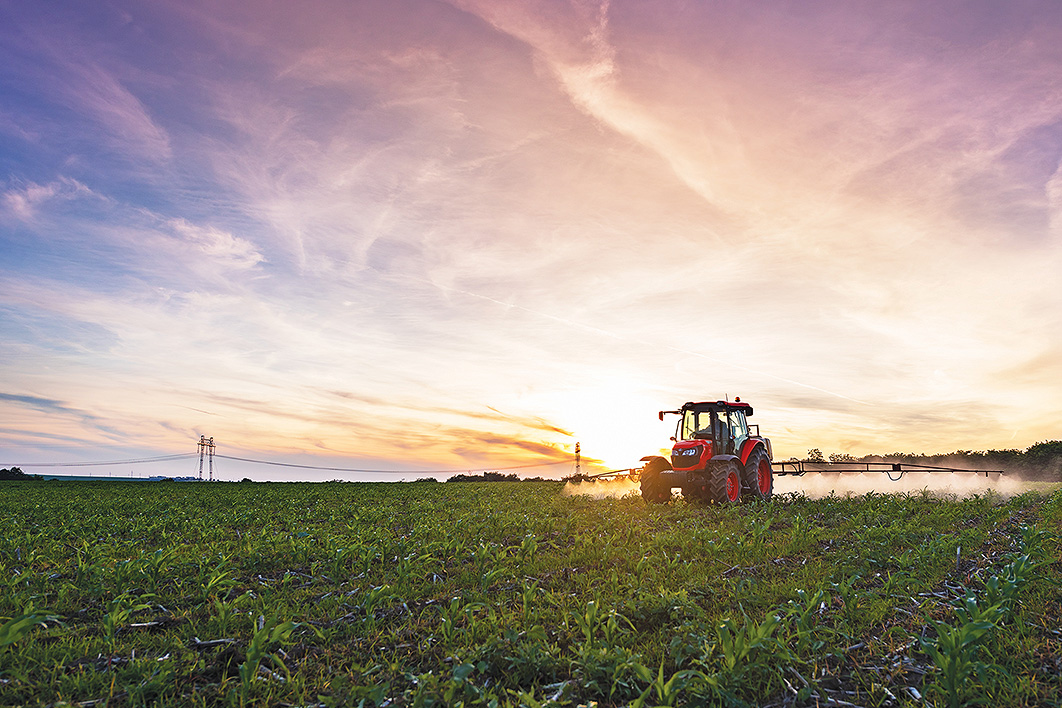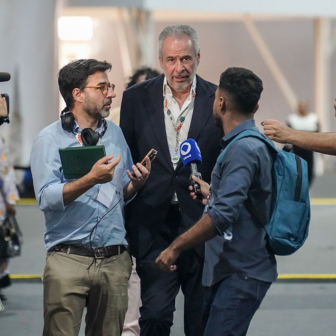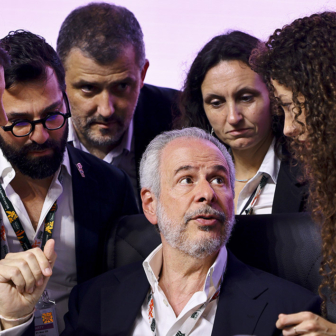If you had told me thirty years ago that I would be moved to write a book in my fifty-fifth year about farming, I would have said you were barking mad. I literally didn’t give a stuff about farming. I was an inner-city journalist who had grown up in the middle of Sydney. Farmers were “out there” — a long way away from any action worth knowing about. They were the remnants of a quaint occupation that Australia used to rely on. Something about a sheep’s back.
Sure, farmers were rolled out any time we wanted to make a statement about Australian identity, but I didn’t know any. They just weren’t relevant to us, the vast majority in the city. We talked about them when there was another drought, though I can’t remember seeing them on television much — maybe the farmer look-alike in the Sydney Olympics opening ceremony riding a horse, but that was about it. Farming had nothing to do with my life and that was fine by me.
And then I met The Farmer. I suppose you could fall in love with someone and hate their occupation. I didn’t; I became thoroughly fascinated by his job. As a committed eater, who wouldn’t love a food grower? But, as you can imagine, I had some preconceptions.
My journalism started under the Hawke–Keating Labor government of the 1980s and my political writing started in the 1990s, at the beginning of the recession Australia had to have. The death of manufacturing was showing me concepts like structural unemployment and inflation — which had previously just been theories in year 12 economics — in action.
But I didn’t take much notice of the structural adjustments going on in farming. I was vaguely aware of agriculture, but it didn’t intrude into what I used to think were the exciting parts of politics, like leadership spills or factional intrigue.
It just gets so much more personal when your livelihood depends on it. The Farmer’s mixed broadacre farm is a commercial-sized operation in southern New South Wales that primarily grows sheep and wheat. It is a family farm, bought four generations ago when the large squatter blocks were carved up during one of the land reform periods. The squatters had taken it from the Wiradjuri people, who have lived here for tens of thousands of years. The descendants of those first inhabitants continue to live here and the traces their ancestors left on the land are unobtrusive but unmistakable.
The way Indigenous people fed themselves, the way they survived and thrived, was underpinned by their system of encouraging the foods they prized, and sculpting land for their long-term use. Landscape was embedded in foundational and spiritual beliefs, while intimately woven with life-giving food. The people’s mark was left on the terrain, but land was considered neither separate nor outside of the people.
I was grafted onto a farming culture that has European roots — whose development was based on an industrial model from the get-go. The colonial leaders’ first job was to feed the settlement, then to export the excess to help feed England, the mother country. Farmers were encouraged and protected in Australia, as they still are in many countries. Land was bestowed, stolen or bought, its bounty was for taking and its capacity considered infinite. Like a rubber band, we thought it could stretch without breaking because that was the economic imperative. To feed people.
So it wasn’t my plan to transplant myself from a city to a country culture on a mid-sized traditional farm, but life has a habit of getting in the way of plans. To be clear, I am a journalist, not a farmer. I don’t have an agricultural degree. I am not like a lot of women who are farmers in their own right, yet only recently recognised. Hell, I don’t even do the books. It’s not my thing. I don’t run The Farmer’s operation and he doesn’t write my books.
But somewhere in the last twenty-five years of living on a farm, and increasingly reporting on rural issues, I started to question the economic agenda that was set in train by the Hawke–Keating and Howard governments in those pivotal decades. Australia, like many countries around the world, was outsourcing anything it couldn’t produce at the cheapest possible price. But how was this going to work for food?
I decided to look at this farming caper I had been living alongside for all these years. I wanted to understand how it came to be, and I discovered that by pulling a thread on a farm, I was quickly taken to foundational philosophical questions about the way we live and how we want to organise our communities and society as a whole. Farming remains as central to the questions of humanity and our future as it ever was. We just don’t think about it that much because we think we solved the food problem a long time ago and there are far more urgent questions to get on with.
I wanted to know one simple thing: why you should care about farming. Or, indeed, whether you should.
At its most basic, farmers use soil and water to grow crops and raise animals. In the act of growing, farmers must look after landscapes. Australian farmers manage up to 60 per cent of the country’s land mass and account for up to 70 per cent of its diverted freshwater extractions. So we all have a stake in farmers doing their job well.
The acts of choosing a farming system for a place, growing food and selling it are like trying to weave a large tapestry. They require care, dexterity and a range of skills. If one thread comes loose, things can start to unravel. Farmers feed us, look after the landscape (or not), punch above their weight for exports and contribute to, or ameliorate, climate change. They play a crucial role in the social infrastructure of many rural communities.
Farming both contributes to and is endangered by the biggest existential threats of our time: climate change, water shortages, soil loss, energy production, natural disasters, zoonotic diseases, population displacement and geopolitical trade wars. That means we need governments to get the policy settings right.
Yet no Australian political party is doing serious thinking about how to knit together food, farming and environmental policies to continue feeding the population while mitigating climate change and biodiversity loss. We remain caught in ways of thinking about farming that hark back to 1788. But the growing market pressure on environmental, health and animal welfare issues means farming cannot be business as usual.
For a brief moment, at the height of panic over the Covid-19 pandemic in 2020, we got a glimpse of what it’s like to live without basic ingredients on the shelves. Bread, pasta, rice, meat and canned goods disappeared from supermarkets. Small local food producers were overwhelmed as people wanted to source food from elsewhere. Food prices rose and global supply chains could not cope with demand.
After years of market-centric structural change, national production capacity was left wanting, and not just in food chains. Face masks, medical equipment and hand sanitiser were the first priorities, but there was also a flicker of discussion about food security.
The Australian government and national farming advocates reacted with campaigns to snuff out any conversation about holes in our food system. Nothing to see here, they said. Yet this was a live opportunity to look around the world and realise why so many countries consider farming and natural resources to be in their national strategic interest.
As I write, Australia has no national food policy, no national drought policy, a Hunger Games–style water policy, a cursory climate policy, and no vision for how land management and environmental assets should fit with farming and food security in a warming climate.
Nor are there any state or national strategies or guiding principles to govern the competition between our limited high-quality food-production land and residential development, mining and energy interests. Conservation, agriculture and land management are dominated by two loud clubs. One says, lock it all up. The other says, it’s my domain and I can do what I like. I’m interested in a more nuanced approach.
I wanted to think about key questions. What do we want to farm? If we concentrate on a few big exports — say beef and wheat — what diversity do we lose along the way? Do we want shorter supply chains for some critical assets in case of future epidemics? Who do we want to do the farming? Do we want to maintain a balance of big corporations at scale, smaller and mid-sized family farmers, including Indigenous landowners, as well as micro-growers? Do we want our land and water owned and managed by 800 companies or 80,000 companies and families? Do we want to put all our environmental and food eggs in those 800 baskets? How do we want to look after the land and water that we rely on for farming in a changing climate? We all need to care about those questions.
As someone who lives and draws an income from food production, I wanted to think about the whole bloody thing, to consider the chain that leads from the soil all the way to the eaters, because as a country we need to understand how farming fits as one piece in one big landscape puzzle. And I wanted to examine themes that resonate around the globe to know where the trends are and what we can expect in the future.
I was also struck by the contradictory demands made of farmers by governments and eaters. We want clean, green food to feed the world. We want scale because we want cheap food. We want family farmers. We want big global capital. We want lots to export to help our balance of payments. We want farmers to stand on their own two feet. We want farming to be like any other business. We want farmers to use the latest technology. We want them to look after the environment. We want them to look after native habitat for declining species. And now we want them to sequester carbon to turn around both their own emissions and some of the rest of the population’s emissions. I think that just about covers it.
My discovery process has not been linear. Like a beagle on the scent of a bunny, it has zigzagged — through time and disciplines; from science to philosophy to politics to culture and back again. It’s been maddening, confusing and confronting. Many times I’ve thought I have bitten off more than I could chew because the act of farming and its ramifications seem so simple but are so complex.
My view is different from others because a view depends on where you are standing. But I hope it sheds a light on important changes going on in our food system, and where the cracks are appearing. I believe it is an urgent conversation. Australian farming is changing rapidly. If you look across this landscape in coming years and you don’t like some of what you see, you can’t say you weren’t warned.
Essentially, we must find a way to knit together the need to grow and supply food with how we manage the landscape. Australia needs a national master plan for its land and food; we need to know how we are to protect our sacred places and unique species for their longevity, and that of the environment and our rural communities.
Responsibility for food, farming and landscape is shared by a number of local, state and federal government ministers and departments, particularly agriculture, environment, health and home affairs. These ministers and departments, and concerned citizens, need to imagine a food, land and water system that walks the path between wild utopia and human reality. We need to devise a plan that looks at the country as a whole and determines how much food is necessary to sustain ourselves into the future and how diverse our food system should be — in what it produces, who produces it and where they live.
This plan would identify and protect the best food production land and intertwine with the national reserve system that maps conservation areas across the country. It would identify high-value conservation areas and prime agricultural land as no-go zones for developments like housing and mining. It might point to partial development areas and open slather sites. It might map out areas designed for clever future housing that would not impinge on limited high-quality food-production land.
A food plan would be both local and global, with short, stout supply chains into our local communities and regions, and then longer freight lines that share our substantial production capacity with the world but particularly with our near neighbours. The priority is a realistic food price that covers the requirements of a healthy ecosystem and the humans who provide their labour to bring the food to your plate.
The plan would acknowledge our reliance for food security on many different imported components, including fuel, machinery and other inputs. It would identify our weaknesses. It would be robust and transparent enough to link to a natural capital account so we could measure the impacts of food production on our natural world and keep building smarter choices. It would measure the nutrition of the food so eaters could reward healthy food systems and encourage wholefood eating in a world that suffers from both obesity and undernourishment.
And while we are at it, why curb our ambition? We rely on land for so many different things and, as the climate changes, those uses are going to change. Our national plan might also include suitable sites for carbon sequestration projects and renewable energy. It would consider a transparent water policy and a visionary soil policy, with its capacity to balance our carbon budget. Finally, this national backyard plan would be afforded the status of the defence portfolio. That would make it of primary importance for the cabinet, the budget and the nation.
Such a food, land and water plan is, surely, a no-brainer. •
This is an edited extract from Why You Should Give a F*ck about Farming, published this month by Penguin.




